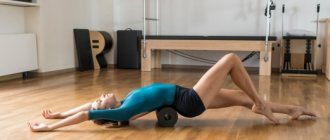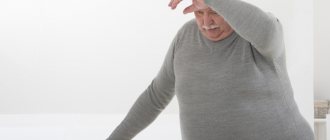Qigong gymnastics is one of the most ancient oriental practices for normalizing the body’s energy balance. The Chinese believed that it was precisely this imbalance that provoked the vast majority of health problems. Modern nutritionists confirm that often the reasons for gaining excess weight need to be looked for “in the head”; the body simply obeys the commands of the brain. Qigong helps to achieve mental balance, thereby improving overall health and at the same time allowing you to gain a beautiful figure.
Qigong breathing exercises: general description
Eastern spiritual practices, which include the Chinese Qigong system, are aimed at gaining mental balance and achieving harmony with the outside world. Its adherents believe that this is possible thanks to the free circulation of Qi - the vital energy of the Universe - in the body.
In China, the Qigong system has many adherents of all ages; It is believed that regular exercise is the key to longevity and maintaining sanity.
The source of this energy is every person. Only if it is present in sufficient “volume” and there is no imbalance, will he be physically and mentally healthy. Therefore, those who practice the exercise disappear from illnesses and even excess weight, because fat is “clumps” of negative energy. The latter largely determined the interest in the Qigong system on the part of many women who want to lose weight.
The movement of Qi energy is a rather difficult process to understand; in the Qigong system it is considered the driving force of the Universe, and its source is all living things
Nervous overload, stress, chronic fatigue provoke constant tension in the body, it is rebuilt, starting to accumulate fat, thus trying to protect itself from negative external influences. Qigong ensures the proper functioning of all systems, including the endocrine and digestive systems, and this eliminates the risk of gaining extra pounds. Gymnastics helps reduce appetite, and accordingly, the problem of overeating disappears.
Qigong is a combination of breathing and physical exercises. Achieving the desired effect is possible only with an integrated approach to training. Physical exercises are quite simple, almost everyone can do them. It is required to hold the body in a certain position, tense and relax muscles, and stretch.
The technique does not promise quick results, but the result will be very lasting. In the process of practicing Qigong, it is the excess weight that is lost. You won't be able to achieve painful thinness. The first results are noticeable after about 40–50 days of training, then weight loss is 3–15 kg per month. A set of exercises should be performed at least 2-3 times a week, ideally every day.
The only drawback of the technique is that it requires seriousness, deep concentration on the process and one’s own feelings, and a responsible attitude towards the exercises. You cannot start training, then quit gymnastics and start it again. It is very important to realize the need to practice Qigong constantly. Not everyone can master the exercises from the descriptions, so it is best to find an experienced mentor, which is often also problematic.
Video: what is Qigong
How exercise helps you lose weight
Chinese sages rightly believed that the root of all health problems should be found in the head. Indeed, a person experiencing constant stress, negative feelings about his own appearance, and emotionally depressed begins to look for an “outlet.” One of the easiest options is delicious food. Such “self-consolation” quickly becomes a bad habit, which is extremely difficult to get rid of. Diets and physical activity help you lose the pounds you have gained, but have no effect on the root cause of the problem, so they come back again as soon as you stop exercising.
This is where Qigong gymnastics can help, helping to improve the functioning of the brain, and then all body systems. Newfound harmony and emotional balance are the best remedy for attacks of “nervous” gluttony and the need to “eat” stress or fear.
Exercising helps you get rid of extra pounds, but not the cause of their appearance.
Its complex action is expressed as follows:
- gaining a feeling of cheerfulness, lightness, a surge of strength, an optimistic attitude towards life, psychological balance, increasing stress resistance;
- strengthening the abdominal muscles through breathing techniques (excess weight begins to disappear from the abdomen, sides, waist);
- general muscle relaxation (improves well-being, neutralizes congestion);
- normalization of lymph flow, which removes waste and toxins from the body;
- oxygen saturation of the blood, it clears the mind, it is also necessary for burning fat cells and is a powerful antioxidant;
- activation of metabolism, better supply of tissues and organs with nutrients;
- a decrease in the feeling of hunger, a gradual consumption of fat reserves accumulated by the body, and a permanent stop to the process of gaining extra pounds.
Video: Qigong exercises that help normalize digestion and lose weight
Advantages
Qigong is not grueling workouts in the gym, not weight lifting, not fitness or aerobics. These are simple exercises that even a beginner can do. The complex includes breathing exercises, diet, stretching and self-massage.
Gymnastics has a number of advantages:
- eliminates excess fat;
- improves human health and well-being;
- helps overcome the effects of stress;
- normalize blood circulation.
Chinese sages believe that one of the advantages of qigong is that lost kilograms will never return.
Available contraindications
It is rarely forbidden to practice Qigong for health reasons, but there are still contraindications:
- any disease (especially chronic in the acute stage), even just a high temperature;
- very severe fatigue due to physical or mental stress, complete loss of strength (you simply won’t be able to concentrate);
- severe mental disorders;
- pathologies of the cardiovascular and nervous systems, blood diseases, neuroinfections;
- chronic diseases of the spine;
Although seemingly easy, exercises using the Qigong method put a serious load on the spine - recent traumatic brain injury or surgery (before the end of the rehabilitation period);
- a course of treatment using potent medications.
For pregnant women and people with vision problems, Qigong gymnastics is indicated only after consultation with the attending physician and under the guidance of an experienced master.
Video: to whom all types of breathing exercises are contraindicated
General rules and recommendations
Following these recommendations is a necessary condition for achieving the desired effect:
- You need to exercise 2-3 hours before a meal or when approximately the same amount of time has passed after it. Neither a full stomach nor an acute feeling of hunger is acceptable.
- During the lesson you should neither overheat nor overcool. Therefore, before it, for example, soft drinks, ice cream, cold showers, and visiting the sauna are excluded.
Visiting a sauna or any other “warming up” of the body is allowed no earlier than 4–5 hours before performing a set of exercises or the same period of time after - The most favorable periods are immediately after waking up or just before going to bed. It is believed that at this time the Qi energy circulates most freely.
- Emotional stability and peace of mind are very important. Eliminate everything that prevents you from concentrating and distracts you - TV, loud music, strangers in the room, try to calm down and relax.
- Exercise only in a well-ventilated area, if possible - outside (if the weather is suitable - not too hot and not too cold), in a large open space (parks, squares).
- Put on light, non-restrictive clothing made of cotton or other natural fabrics, and take off your shoes. Exercise barefoot or wear breathable socks. If you are sweating, change clothes to avoid hypothermia.
- Perform all movements slowly, measuredly, smoothly. Any sharpness and abruptness are excluded.
- Give up cigarettes, minimize alcohol consumption, and give preference to healthy foods.
Qigong considers vegetarianism to be the ideal nutritional system, but many, for one reason or another, are incapable of this
Lana Anatol's technique
Lana Anatol is one of the active popularizers of the Qigong technique, who created her own complex, the main goal of which is weight loss. The exercises she offers are more “soft”, the emphasis is on stimulating three “foci” in the body. They are located in the navel, solar plexus and in the center of the chest. The author’s exercises aim to “fill” them with energy, ridding the body of its deficiency.
Based on classical Qigong gymnastics, Lana Anatol created a version of it, aimed specifically at losing weight
A kind of “warm-up” is deep breathing (at least 3-5 minutes). You need to concentrate on the process, as if going into meditation, without reacting to external stimuli. Then press your palms to your stomach in the intestinal area, continuing to breathe in the same rhythm and pace (1.5–2 minutes).
Next, change the rhythm by making sharp, short inhalations and exhalations. Try to fill your stomach with air as much as possible and push it out. After 30 seconds, begin to massage your stomach in a clockwise direction with slow circular movements. After making 80–100 movements, again switch to slow deep breathing.
Video: lesson using Lana Anatol’s method
Frog rocking on a wave
- We lie on our backs, bending our knees and pressing our feet to the floor parallel to each other.
- One hand is on the stomach, the other is on the chest.
- We take a slow, calm breath, greatly expanding our chest and strongly drawing in our stomach.
- Now - exhale, with which you need to draw in your chest and, conversely, inflate your stomach like a balloon, but without applying too much effort.
With the help of a frog on a wave, we learn to control our stomach and get rid of excessive gluttony.
Fifteen-minute Qigong complex for weight loss
The complex is quite simple, so it is suitable for beginners:
- Pressing your palms to the navel area, breathe deeply, inflating and retracting your stomach as much as possible.
- Hug yourself by the shoulders. Inhaling deeply, throw your head back and spread your arms, squeezing your shoulder blades together. As you exhale, round your shoulders and back, lowering your chin as close to your chest as possible.
- Using the edge of your palm, lightly tap your hands one at a time, moving as you inhale from the wrist to the shoulder, and as you exhale, in the opposite direction.
- Stretch your arms, lower your shoulders. Keep your hands facing downwards with your fingers spread out. As you exhale, slowly tilt your head to the side, and while inhaling, “roll” it from back to front.
- Stretch your arms forward, turn your hands with your palms up. While breathing steadily, lightly tap your wrists together.
- As you inhale, smoothly spread your arms outstretched in front of you to the sides, opening your chest to the maximum, and exhaling, bring them back to the starting position.
- As you inhale, raise your arms outstretched to the sides, and as you exhale, bring them together in front of your face.
- Imagine that you are holding a clot of energy with a diameter of 10–12 cm in your outstretched hands. Try to visualize it, close your eyes, and feel this energy. Slowly bring your palms together and spread them in time with your breathing, imitating the pulsation of the ball.
- Repeat the first exercise.
Video: a set of Qigong exercises for beginners
Lotus bud
- We sit on the floor in the lotus position (cross-legged) or on a low stool.
- The outer side of the wrists rests on the hips, and the hands should lie one on top of the other (left on top for women) with palms up.
- Do not touch the wall or the back of a chair with your back, keep your back straight, relax your facial muscles and touch your tongue to the upper palate.
- We relax and remember the joys we have experienced, and tune in to positive gymnastics.
- We regulate our breathing for 5 minutes, inhaling and exhaling deeply, evenly and slowly.
- For the next 5 minutes, we focus on exhaling, completely relaxing the body during it.
- Now we breathe naturally, without controlling our breathing at all for 10 minutes, and bring it back under control again.
Exercise stimulates metabolism, helps restore strength and get rid of many chronic diseases.










